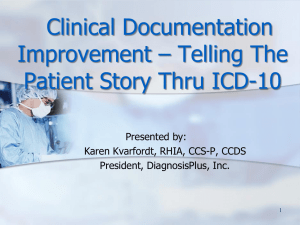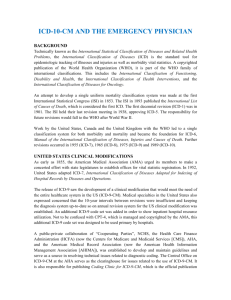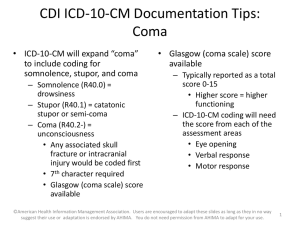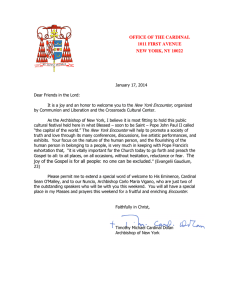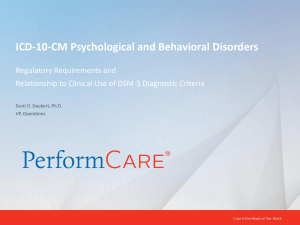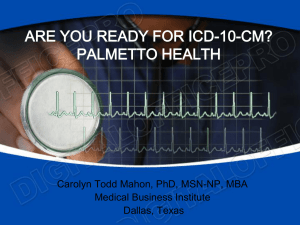Documentation Considerations by Chapters in ICD-10-CM
advertisement
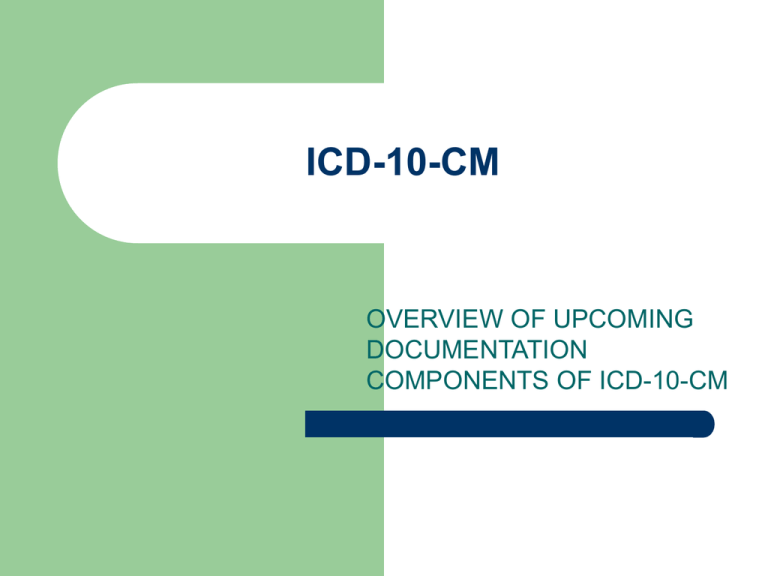
ICD-10-CM OVERVIEW OF UPCOMING DOCUMENTATION COMPONENTS OF ICD-10-CM Presenter Sue Haley, RHIT, CCS, CCDS AHIMA certified ICD-10 instructor Over 20 years coding experience – Both inpatient and outpatient OCTOBER 2013 ICD-9-CM 3-5 characters Only V & E codes start with letter Limited space for adding new codes Cannot identify laterality ICD-10-CM 3-7 characters ALL codes start with letter Flexible for adding new codes Can identify laterality EXCLUDES NOTES ICD-10-CM – Exclude notes are better defined in ICD-10 – EXCLUDES 1 means don’t code together – EXCLUDES 2 means “not included here”. Therefore, if both conditions exist, two codes are necessary Official Guidelines for Coding & Reporting Conventions for ICD-10 www.cdc.gov/nchs/icd/icd10cm.htm Many new and revised coding guidelines for ICD-10-CM but also newly published guidelines for ICD-10-PCS AHA Coding Clinic for ICD-9-CM will not be converting their guidelines for ICD-10-CM use Documentation Considerations by Chapters in ICD-10-CM Infectious & Parasitic Disease – – Blood & Blood Forming Organ – – New terminology to review Includes the drug resistant classifications New terminology to review Greater specificity Endocrine, Nutritional, Metabolic – Greater specificity for diabetes & malnutrition Documentation Considerations by Chapters in ICD-10-CM Mental & Behavioral Disorders – – Nervous System – Significant changes in the specificity of sleep disorders Eye & Adnexa (new chapter) – – Many changes to terminology Tobacco use vs dependence Terminology changes Laterality classified Ears & Mastoid (new chapter) – Laterality classified Documentation Considerations by Chapters in ICD-10-CM Circulatory – – – Respiratory – Asthma now classified as mild intermittent & three degree’s of persistentmild, moderate, and severe Digestive – – – Includes gangrene Hypertension no longer classified malignant, benign, or unspecified. Definition on coding AMI now 4 weeks Ulcers no longer specified as obstructive Bleeding assigned to gastritis, duodenitis, diverticulosis Crohn’s has specific sites & now identifies that with complications Skin & Subcutaneous – More specificity in sites & severity of decubitus ulcers Documentation Considerations by Chapters in ICD-10-CM Musculoskeletal & Connective Tissue – Fractures further define encounters as: A initial encounter for fracture B Initial encounter for fracture routine healing G subsequent encounter for fracture delayed healing K subsequent encounter for fracture with nonunion P subsequent encounter for fracture for malunion S sequela Documentation Considerations by Chapters in ICD-10-CM Musculoskeletal & Connective Tissue – Uses the GUSTILO open fracture classification – Mechanism of injury Soft tissue damage Degree of skeletal involvement Physician teaching opportunity during your implementation of ICD-10 Documentation Considerations by Chapters in ICD-10-CM GUSTILO open fracture classification – – – – – – – – – – B C E F H J M N Q R initial encounter open fx type I or II initial encounter open fx type IIIA, IIIB, or routine healing subseq. encounter open fx type I or II with routine healing subsuq. encounter open fx type IIIA, IIIB, or IIIC with routine healing subseq. Encounter open fx type I or II with delayed healing subseq. Encounter for open fx type IIIA,IIIB, or IIIC with delayed healing subseq. Encounter for open fx type I or II with nonunion subseq. Encounter for open fracture type IIIA, IIIB, or IIIC with nonunion subseq. Encounter for open fx type I or II with malunion subseq. Encounter for open fx Documentation Considerations by Chapters in ICD-10-CM – Musculoskeletal & Connective Tissue Laterality New definitions associated with classification of joint involvement (direct, indirect, post-infective) – Direct organism invades synovial tissue and microbial agent is present in joint – Indirect no joint involvement – Post-infective antigen present Documentation Considerations by Chapters in ICD-10-CM Musculoskeletal & Connective Tissue – Pathological fractures have 3 categories: Due to neoplastic disease, Due to osteoporosis, Due to other specified disease Documentation Considerations by Chapters in ICD-10-CM Diseases of genitourinary system – New terminology – Post-traumatic urethral strictures will need to identify patients gender Documentation Considerations by Chapters in ICD-10-CM Pregnancy, childbirth, & periperium – Episode of care is no longer classified – Trimester is now used to classify the condition 1st trimester- less than 14 wks and 0 days 2nd trimester- 14 wks 0 days to less than 28 wks 0 days 3rd trimester- 28 weeks 0 days until delivery Documentation Considerations by Chapters in ICD-10-CM Pregnancy, childbirth, & periperium – – – Physician’s must calculate the weeks, the coder can not Coder can use the weeks to determine the trimester if the physician documents The time frames for differentiating the abortion from fetal death have changed from 22 to 20 weeks. Documentation Considerations by Chapters in ICD-10-CM Signs, Symptoms, and abnormal clinical and laboratory findings, NEC – Fairly substantial classification changes to hematuria – GLASCOW coma scale (TBI/sequelae CVA) – Primarily used by trauma registries & research – Organizational decision the frequency of capturing a Glasgow coma scale scores Documentation Considerations by Chapters in ICD-10-CM GLASCOW COMA SCALE 7th digit character will indicate: 0 unspecified time 1 in the field (EMT or ambulance) 2 at arrival to ER 3 at hospital admission 4 24 hours or more after admission Documentation Considerations by Chapters in ICD-10-CM Injuries, poisoning, & certain other consequences of external causes – New category for underdosing – Taking less of a medication than is prescribed Classify burns and corrosions (new term ICD-10) Documentation Considerations by Chapters in ICD-10-CM – Injuries, poisoning, & certain other consequences of external causes – New extensions for identification of: A initial encounter D subsequent encounter S sequela – Documentation Considerations by Chapters in ICD-10-CM Injuries, poisoning, & certain other consequences of external causes Fractures further define encounters as: A initial encounter for closed fracture B Initial encounter for open fracture D subsequent encounter fracture routing healing G subsequent encounter for fracture delayed healing K subsequent encounter for fracture with nonunion P subsequent encounter for fracture for malunion S sequela Closing Remarks Encourage review of ICD-10 coding guidelines now to become familiar with similarities and differences Pay close attention to new guidelines for PCS and the new guidance being provided Develop educational plans that incorporate the new documentation requirements Don’t wait until 2013 start now!

